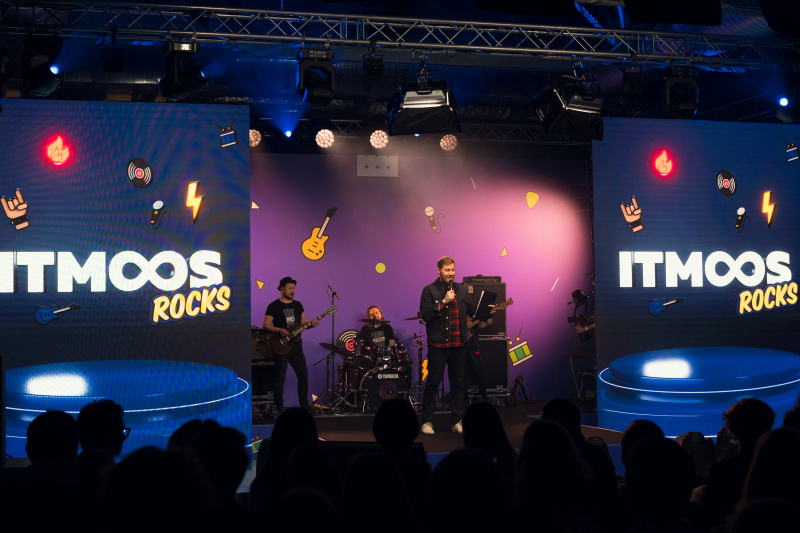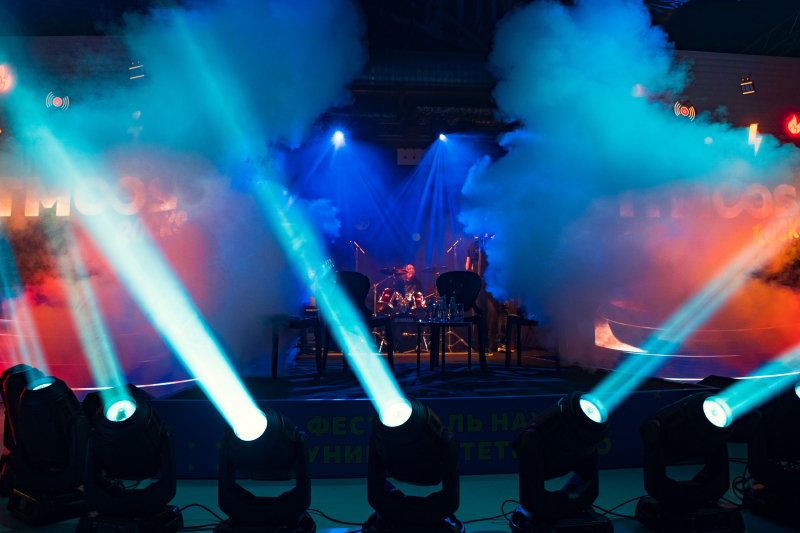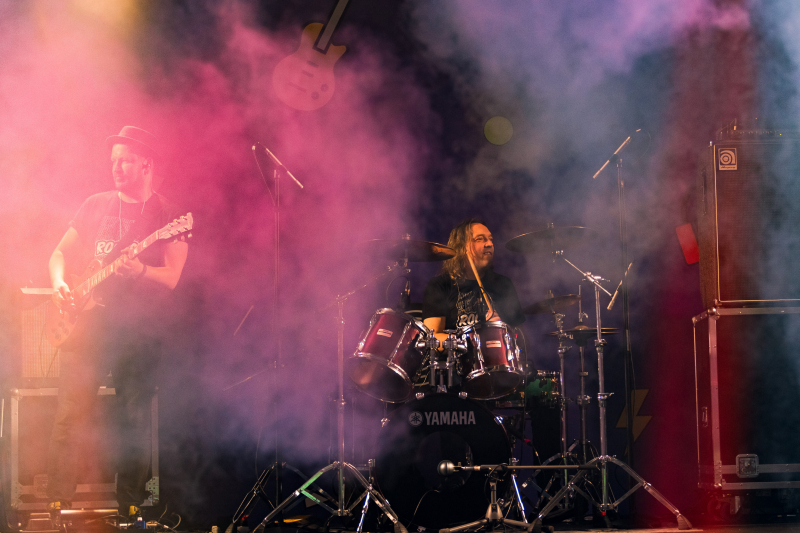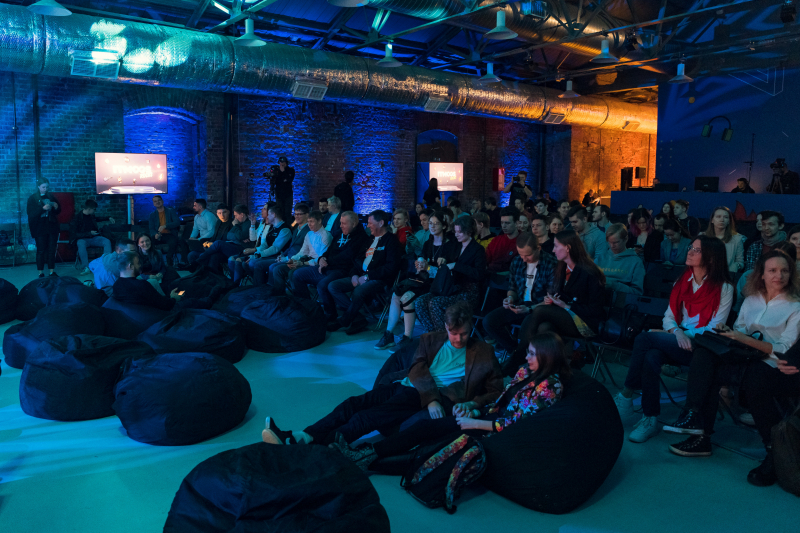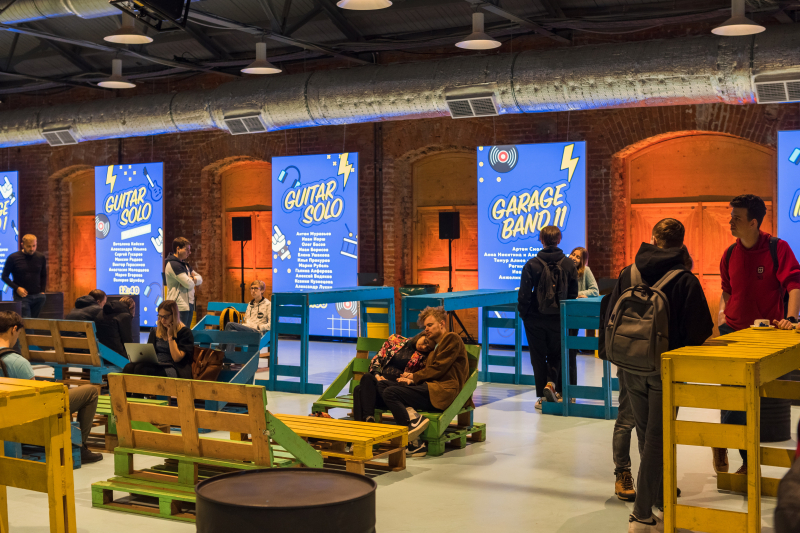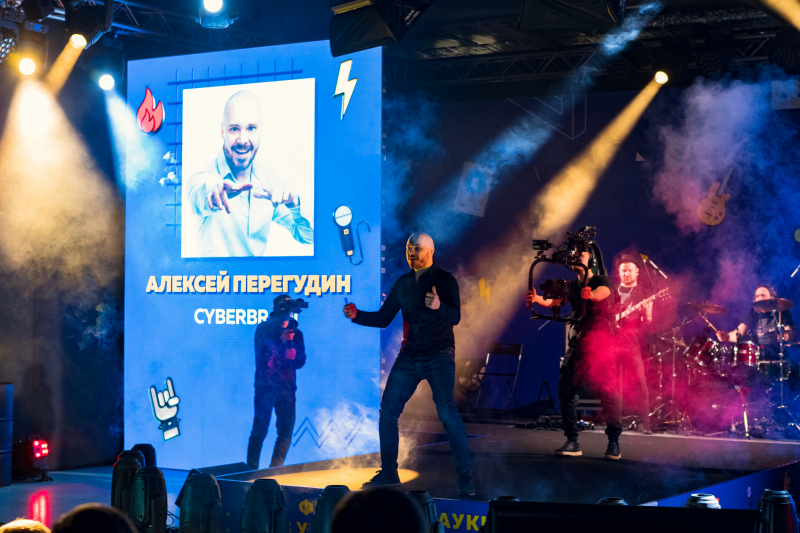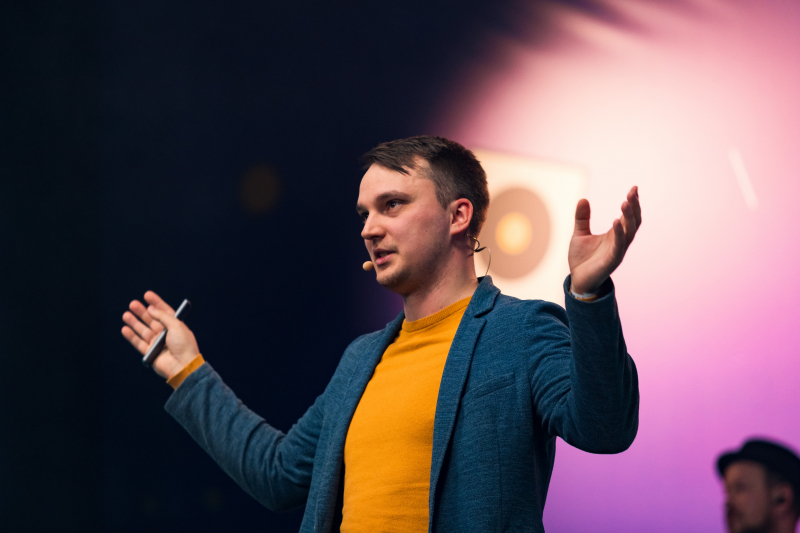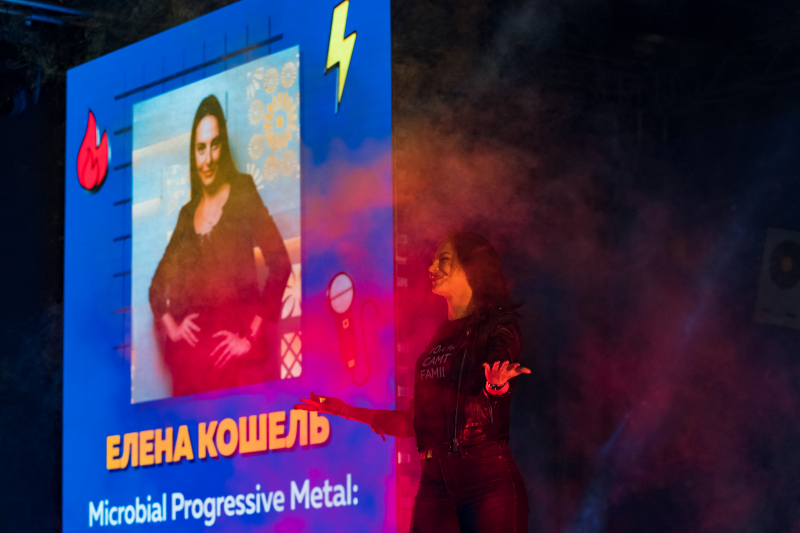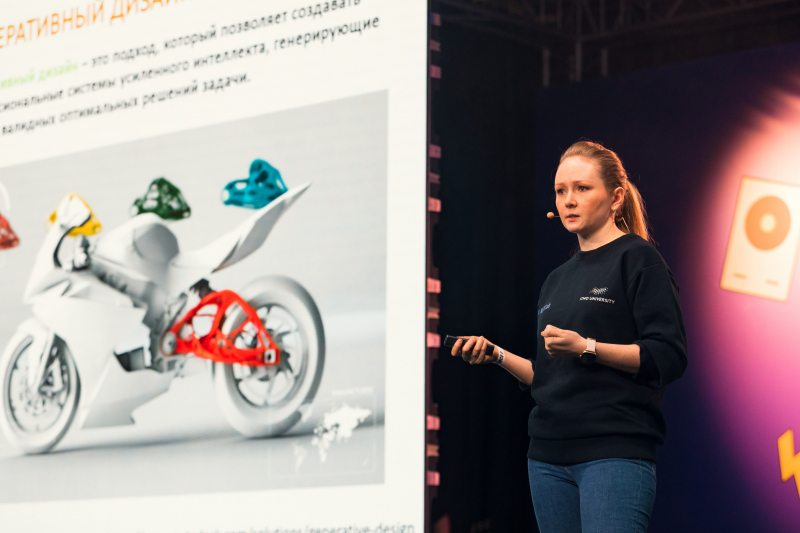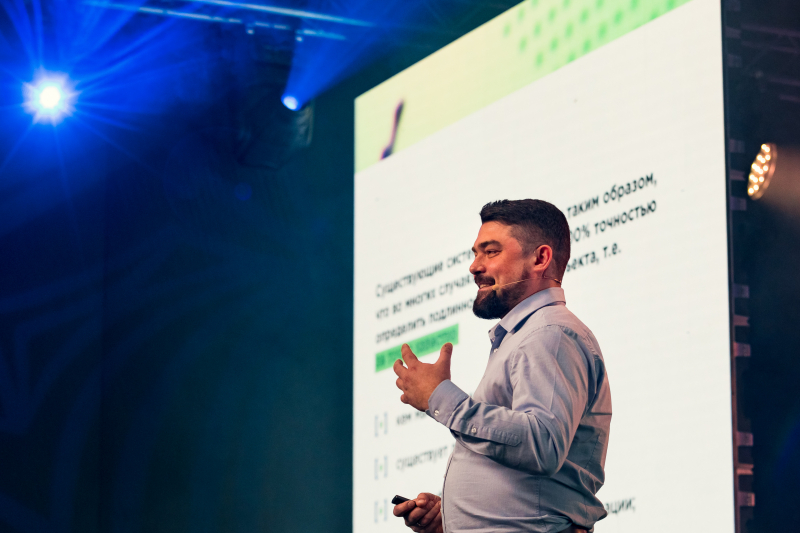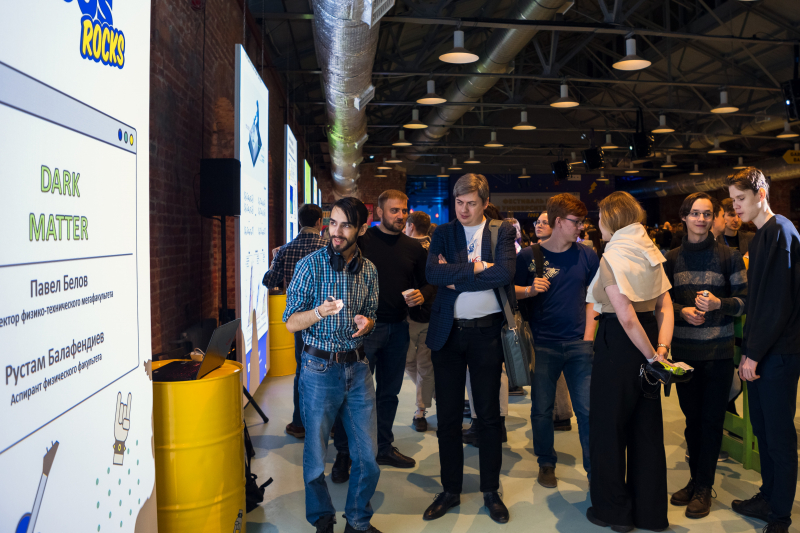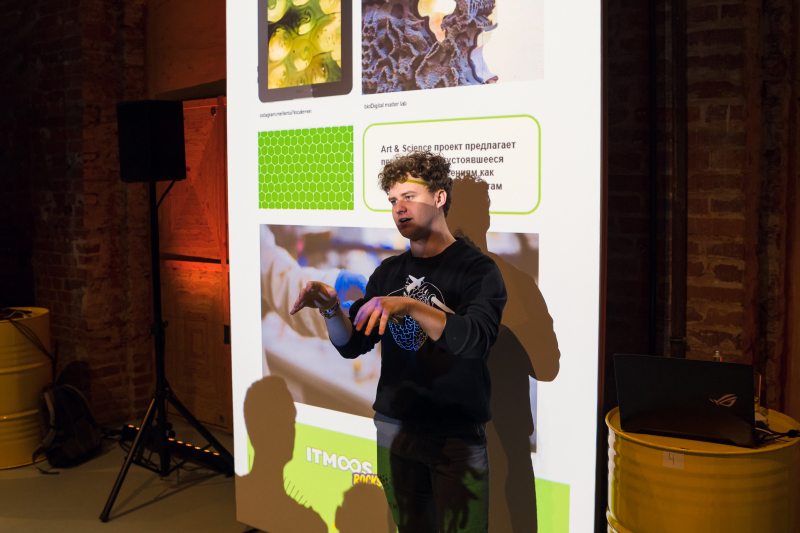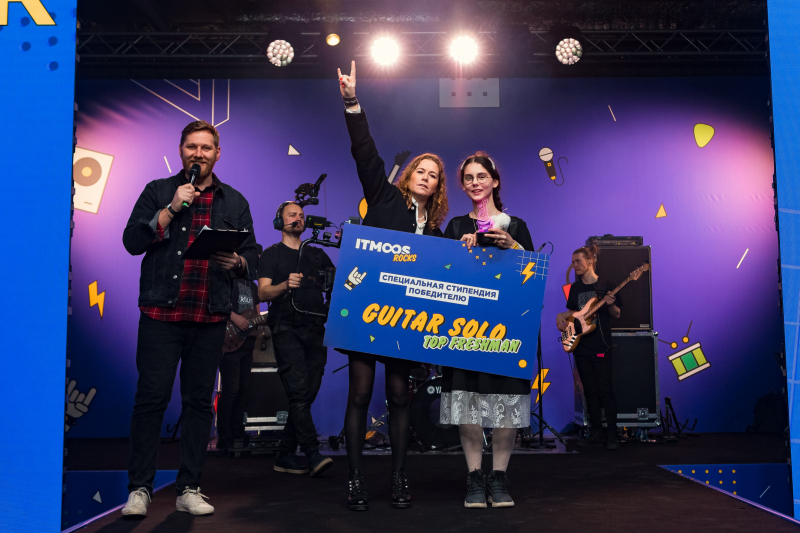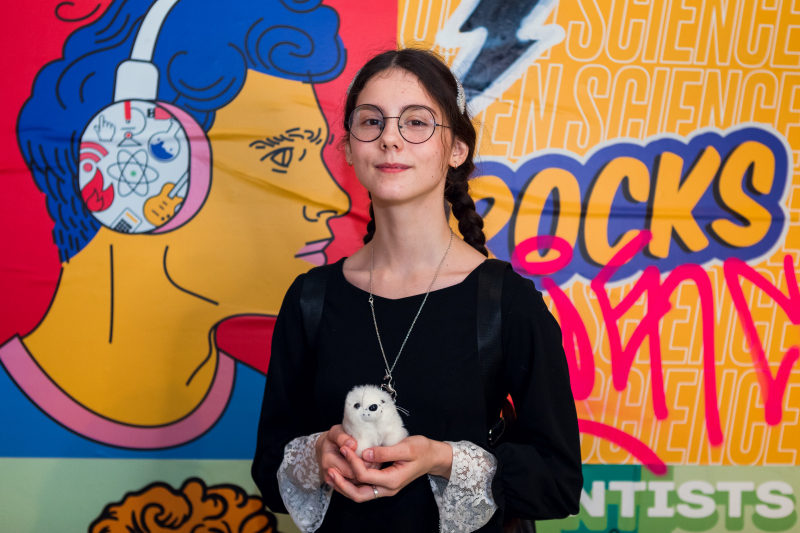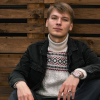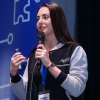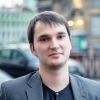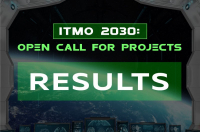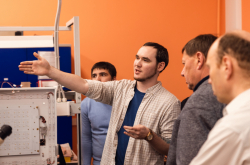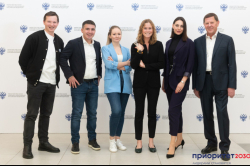The event took place at one of the key Sevkabel buildings – a brick garage built in the 19th century that was initially used for storing metallic and wooden cylinders. For the special event, the interior was made much more fashionable: the hall was decorated with digital panels, a photo zone, and DIY tables made of painted boxes and metallic barrels. But all eyes were turned to the big stage with drums, smoke machines, and huge screens. This wasn’t a typical scientific conference but a real rock festival with scientists as headliners.
“We chose rock music as the theme because we’re convinced our researchers are true rockers. They don’t just sit in their labs wearing suits and bow ties – they’re vibrant, active, energetic, and fun. We arranged a conventional conference before but this time, we decided to shake it up and let scientists communicate and express themselves in a more informal environment. Before the event, we held workshops for speakers and helped the participants with their presentations and overcoming stage fright. We think such a format will allow us to attract more people to science and prove that it’s not as inaccessible as it may seem, it’s hip and fashionable,” says Maria Yakovleva, an organizer of Open Science Rocks.
Heavy Metal: science in a nutshell
The first Open Science Rocks session was about breakthrough research conducted at ITMO as part of the 2030 Development Strategy. The speakers shared what kind of challenges they have to face in 2022 in science slams.
Alexey Peregudin, a research associate at the School of Computer Technologies and Control, let the audience travel in a time machine during his CYBERBRAIN presentation – they went all the way from the past and its theories on neural networks and AI to the present, where these technologies are partially implemented, and further, to the future, where AI has a brain and a body. Alexey believes that neural networks should not only help with diagnostics and investigations but become real surgeons and Sherlocks themselves – that’s why they need to have bodies.
In her turn, Anna Kalyuzhnaya, the head of the Natural Systems Simulation lab at the National Center for Cognitive Research, shared that she doesn’t think abstract neural networks are in the past – in her lecture titled Does AI Dream of Evolution, the audience learned about algorithms that are able to evolve just like living organisms. During their development, they mutate, exchange genomes, and even undergo natural selection.
Associate professor at the ChemBio Cluster Elena Koshel also talked about evolution but in terms of living beings. In her presentation, Microbial Progressive Metal: Survival Technologies in Microbial Apocalypse, she talked about creatures that are far more advanced than people when it comes to evolution – microbes. One of the biggest healthcare issues – resistance to antibiotics – is caused by the high efficiency of their adaptation mechanisms, their rate of reproduction, and omnipresence. However, there are ways to fight it.
Danil Zakoldaev, the dean of the Faculty of Secure Information Technologies, reminded us that we should not only take care of our health but also pay attention to security of the informational technologies we use. In the presentation titled CyberSecurity: Risks and Dreams, he talked about how Sberbank specialists ensure the cybersecurity of their products and what we should do to use our devices safely.
Dean of the Faculty of Photonics Sergey Makarov discussed relevant photonics materials in his presentation Perovskite Technologies in the New Age. Thanks to the unique properties of perovskites, they are used in the creation of screens with high color fidelity, tiny lasers, semitransparent light-emitting diodes, luminescent ink, and flexible x-ray machines. According to scientists, such materials can help make use of solar energy to fulfill the need for energy supply for the entire population of our planet.
Garage Band: visual aids to the rescue
Even coffee and lunch breaks were eventful: that’s when speakers answered questions from the audience and creators of the university’s most fascinating projects made digital presentations of their work. Among them were Vadim Belyaev and Timur Aliyev, Master’s students at the Infochemistry Scientific Center. During the poster session, they talked about a multielectrode electrochemical system for the detection of antibiotics in milk. Their idea can be automated and scaled up, as the researchers used computer models and a multipanel platform. In order to optimize the process of training the neural network, they’ve decreased the number of antibiotics and increased the amount of data.
Open Jam: Rector and Vice Rectors on key values
The second session of Open Science Rocks was something of a public podcast. Vladimir Vasilyev, the Rector of ITMO University, Daria Kozlova, the First Vice Rector and head of ITMO’s 2030 Development Strategy, and Vladimir Nikiforov, the Vice Rector for Research, answered questions about the university, development of science in Russia, and approaches to education.
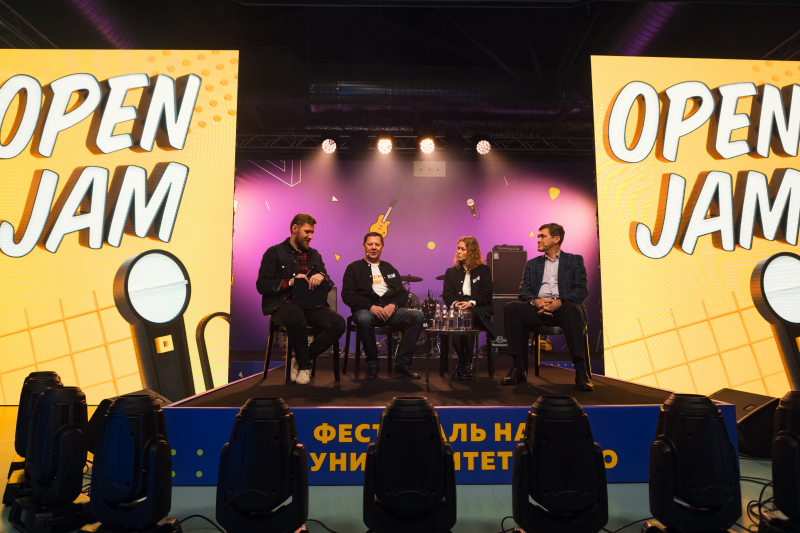
Open Jam at Open Science Rocks. Photo by Dmitry Grigoryev, ITMO.NEWS.
What should first and foremost motivate people to do science – a personal interest or social needs? If we accept that modern science should first of all be useful in practice, what about scientists engaged in fundamental research? How do you set up scientific collaborations in the current conditions?
According to Vladimir Vasilyev, ITMO University is an open institution that has never stopped functioning and is open for cooperation with partners from the educational sector and the industry now more than ever. Borders shouldn’t exist in science, as researchers all over the world work on common tasks and only together they can face global challenges. According to Daria Kozlova, ITMO has always been loyal to these ideas and sees the potential for its growth in the community of like-minded specialists.
“Human connection will stay unchanged – we will still have the “human-to-human” ties. And we believe that they will allow us to make the hyperjump,” says Daria Kozlova. “As for the institutional level, we are certain that we will still have international collaborators. We now have opportunities in another part of the world: we have great partners in Mexico, active collaborators in China, and we expect new partnerships in Latin America. These are the directions we will be focusing on now. Moreover, I am sure that now we can build ITMO as a university beyond physical borders with its core being in a community of researchers all around the world. No matter where we are, we have common goals and values. We are turning into a great distributed system.”
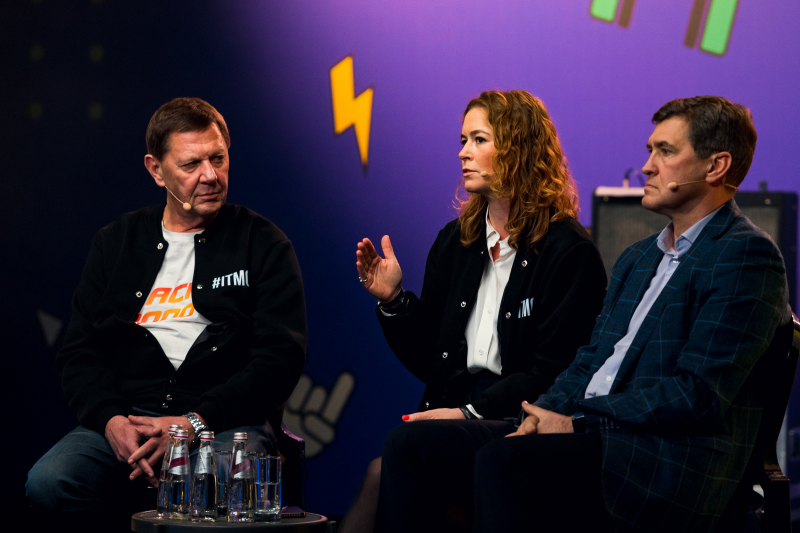
Open Jam at Open Science Rocks. Photo by Dmitry Grigoryev, ITMO.NEWS.
Apart from that, the speakers discussed the construction of ITMO Highpark, which is going according to the initial plan; the first stage will be completed in 2024. Alongside the construction, ITMO specialists will be working on the educational and research fields to be developed at Highpark. This is the process that will engage the whole university community – from staff and students to partners.
“ITMO Highpark is not just a complex of buildings, it’s a new model for the collaboration between the university and the industry. That’s why everyone should be involved in its development: not just the university administration, but also our scientists, business representatives, and our wide community,” noted Daria Kozlova.
ITMO Open Science Rocks also promoted the growth of the university community. Its visitors not only got the chance to learn about the university and meet its staff, but also discuss potential joint projects.
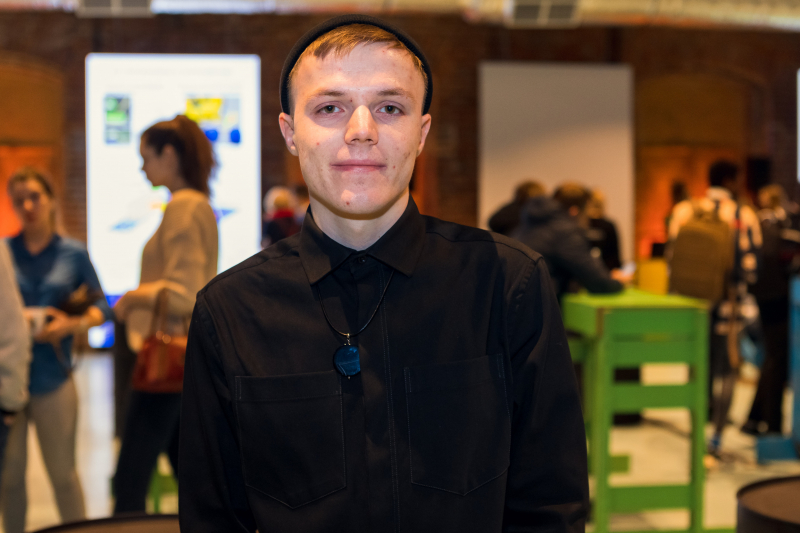
Dmitry Bykov. Photo by Dmitry Grigoryev, ITMO.NEWS
“This event is an excellent opportunity to learn what your colleagues are working on. At my School, I am engaged in public relations, so this is very important for me. This year, I especially appreciated the space for informal communication. For instance, just now I bumped into a colleague, and we came up with a new project right on spot,” shared Dmitry Bykov, a Master’s student at the School of Physics and Engineering.
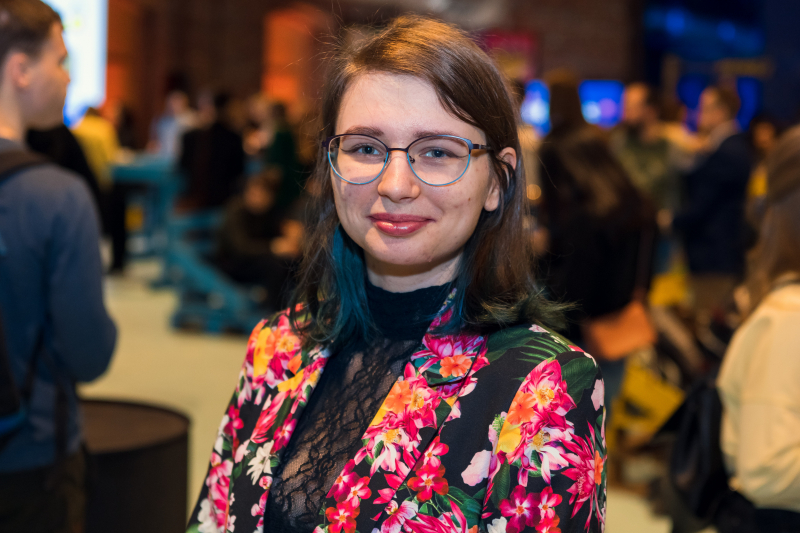
Sofia. Photo by Dmitry Grigoryev, ITMO.NEWS
“I came here to meet the organizers of Open Science Rocks and experience another level of public events: choosing Sevkabel as the venue is an interesting format that brings together music and science. I want to suggest a joint project and also talk about my university’s achievements. We’ve already ran a small TEDx-like event similar to Open Science Rocks, but we didn’t have as much support from the university and its partners,” says Sofia, a student at the Herzen State Pedagogical University.
Guitar Solo: present your research in three minutes
Guitar Solo was the most dynamic part of the event because it featured short talks about the most important and original results achieved by the university’s departments over the last two years. First, school and university students, winners of the video pitch contest at the Congress of Young Scientists, presented their projects within a special section called TOP FRESHMAN.
“I am now in 11th grade and I want to get into ITMO because it’s a cool place where you can dive into science as a very young student. There are even special programs for school students. I really wanted to do science, but I didn’t have anywhere I could go to do it. So I started taking part in various contests and applied for special events held at ITMO, where I was invited to intern at PeroLab and the Infochemistry Scientific Center. Open Science Rocks gave me the opportunity to present my project in front of a wide audience, learn what is happening in science now, and meet new people. Science has to be accessible to the public, so I think it’s great to have it at the core of such dynamic and modern events,” says Alexandra Ilyina, the winner of the TOP FRESHMAN section.
According to those in the audience, at first it seemed that it’s impossible to condense a whole research project into three minutes, but actually such short presentations are a great way to get into a specific field – and learn more about the project afterwards.
“I was really impressed by these short talks. When I was helping one of my students to get ready for the Congress of Young Scientists, we had to work hard in order to fit the project into a seven-minute talk – and here there were only three minutes. But actually, it depends on the purpose of the presentation: if you want to talk about your research in detail, then three minutes isn’t enough, but if you want to just give a general description of your field or talk about your lab, then it’s totally possible. For instance, I was really impressed by hybrid labs in art & science and I am planning to participate in one,” shares Maria Stepanova, a student at the Physics and Technology of Nanostructures Master’s program.
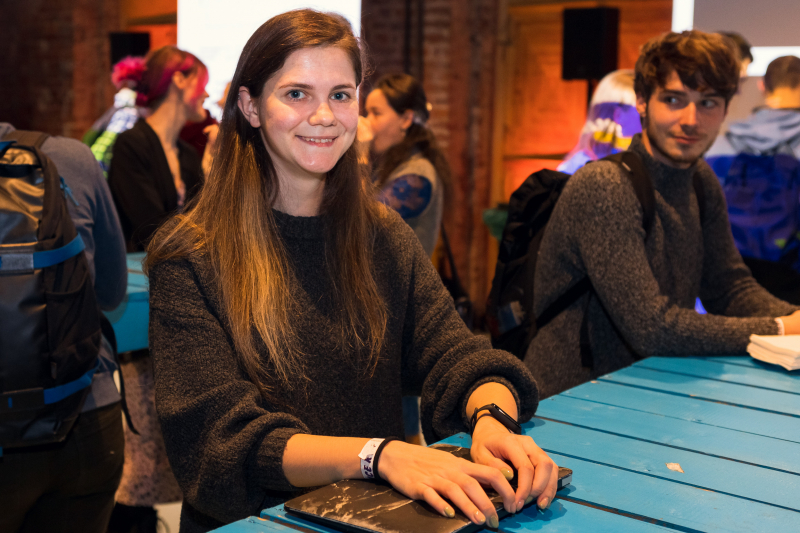
Maria Stepanova. Photo by Dmitry Grigoryev, ITMO.NEWS
Industrial Battle: the best duets
The event concluded with joint presentations by heads of companies and ITMO’s leading scientists – they presented collaborations between industry and academia. For instance, the visitors learned about:
- smart robots by ITMO’s Laboratory of Biomechatronics and Energy-Efficient Robotics and Sberbank Robotics Laboratory;
- new drone verification and validation methods by the Faculty of Secure Information Technologies and JSC NIIAS;
- a digital platform for St. Petersburg museums by ITMO’s Center for Digital Humanities and the State Peterhof Museum Reserve;
- new dental implants by ITMO’s International Research Laboratory for Micro- and Nanotechnology Lasers and LLC Laser Center;
- achievements in the field of industrial AI by ITMO’s Research Center “Strong AI in Industry” (whose key industrial partner is Gazprom Neft).
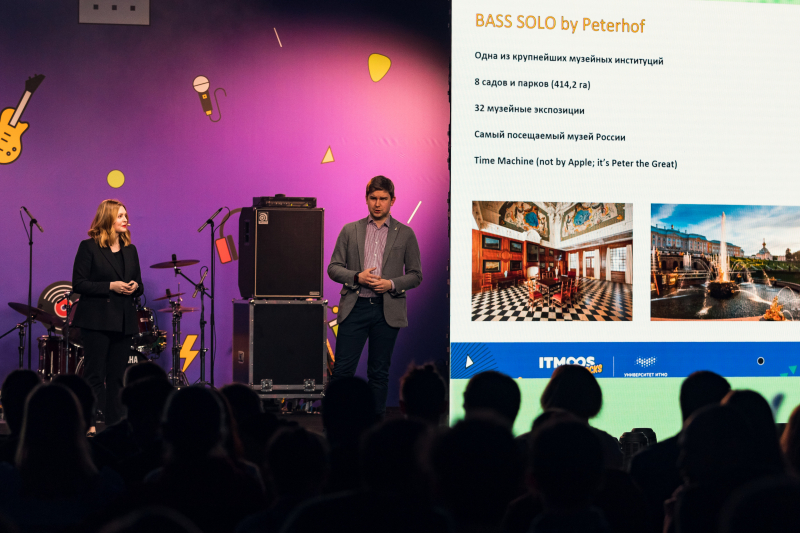
Industrial Battle session at Open Science Rocks. Photo by Dmitry Grigoryev, ITMO.NEWS
Open votes for best speakers in every section were another feature of Open Science Rocks. Alexandra Ilyina was named best in Guitar Solo TOP FRESHMAN and Svyatoslav Moroshkin aced the Industrial Battle. Alexey Peregudin, who took part in the Heavy Metal section, was named the star of the event.
Not only those who topped the Science Chart got their awards, however – some special prizes were also presented to winners of presidential grants for young scientists. One of them was Alexander Podshivalov, a scientist from the Center for Chemical Engineering. He does research on the development of bioresorbable suture materials from chitosan and gelatin.
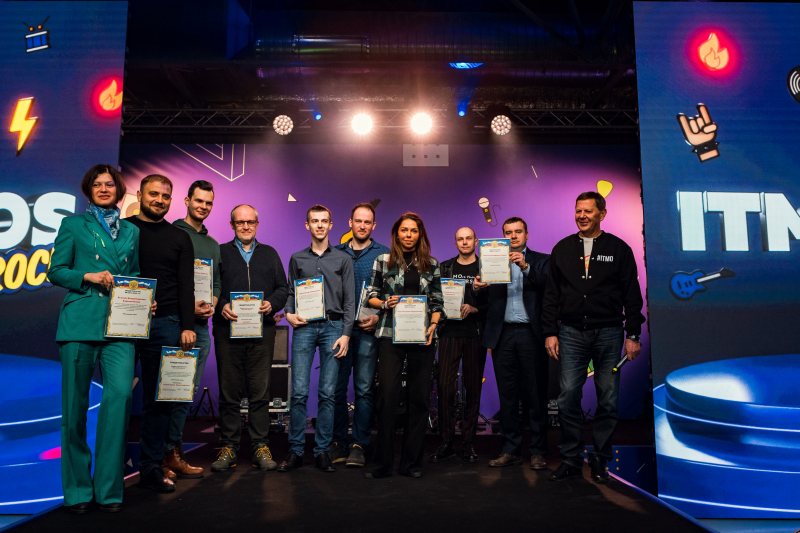
Winners of the presidential grant contest. Photo by Dmitry Grigoryev, ITMO.NEWS
“I was invited as a speaker, but when I learned that it will be an informal “rock talk” I was a little confused and decided to see how it works first. It’s a very challenging task to present fundamental research in an accessible, fun, and dynamic format. But after talking to my colleagues and watching them get ready for their presentations, I feel ready to present my work as a speaker too – if I am invited next time. Although I will come anyway: I love rock, I love science, and this event brings them together!” shares Alexander Podshivalov.
You can watch the event in full here (in Russian) or read our live text broadcast on Telegram (it’s in Russian, too, but the app has an in-built translation tool).
